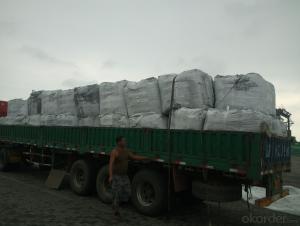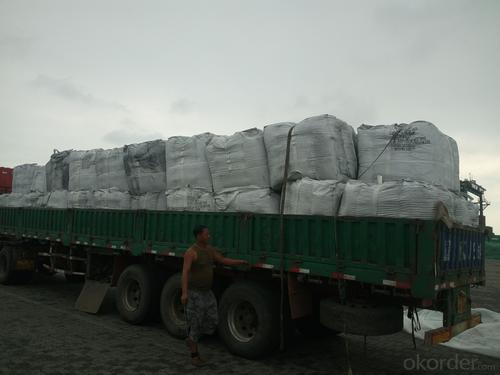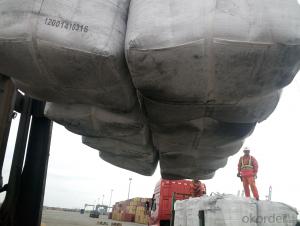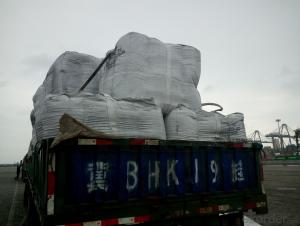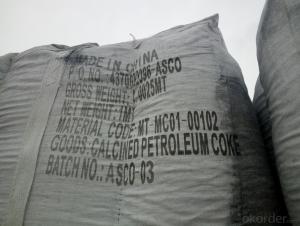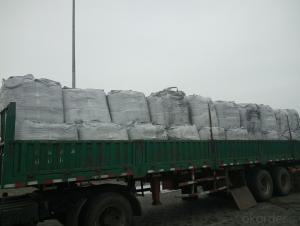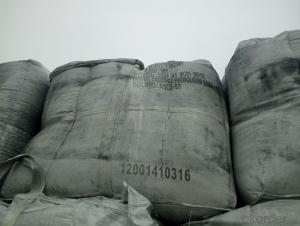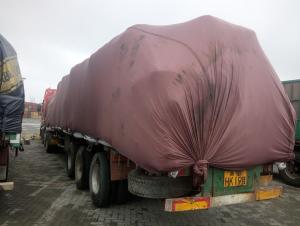Calcined Pitch Coke with Ash 0.5 percent max uses as furnace
- Loading Port:
- Tianjin
- Payment Terms:
- TT OR LC
- Min Order Qty:
- 21 m.t.
- Supply Capability:
- 8000 m.t./month
OKorder Service Pledge
OKorder Financial Service
You Might Also Like
Introduction
Pitch Coke/Coal Tar Pitch is a kind of black brittleness and blocky piece, lustrously at normal temperature. It has special odour and poisonous and can be easily flame when melting, second-grade inflammable solid.
Pitch Coke/Coal Tar Pitch is obtained from powerfully processed coal tar. Compared to petroleum asphalt, the adhesiveness is better. Coal Tar Pitch is high quality tar production with high fixed carbon. It has excellent adhesion, waterproofing and resistance against seawater, oil and various chemicals. In these properties, it is much better than petroleum asphalt tar.
It can be used to produce painting, electrode, pitch coke, and tar felt. It also can be used as fuel and the raw material of asphalt carbon black.
Features:
The morphology, chemistry and crystallinity of recarburisers have a major impact on the overall casting cost. The combined application and cost benefits, which are derived through the use of Desulco, enable foundries to manufacture castings in a highly cost effective manner.
reduces
Recarburiser consumption
Power consumption
Inoculant consumption
MgFeSi consumption
Furnace refractory wear
Scrap rate
Tap to tap time
Slag inclusions risk
Chill
increases
Casting microstructure
Productivity
Process consistency
Carbon Recovery
Compared with calcined petroleum coke, acetylene coke and
graphite electrode scrap, Desulco yields the highest carbon
recovery and fastest dissolution time
Specifications:
CPC | |||
F.C.% | 98.5MIN | 98.5MIN | 98MIN |
ASH % | 0.8MAX | 0.8MAX | 1MAX |
V.M.% | 0.7 MAX | 0.7 MAX | 1 MAX |
SULFUR % | 0. 5MAX | 0. 7MAX | 1MAX |
MOISTURE % | 0.5MAX | 0.5MAX | 1MAX |
Pictures:
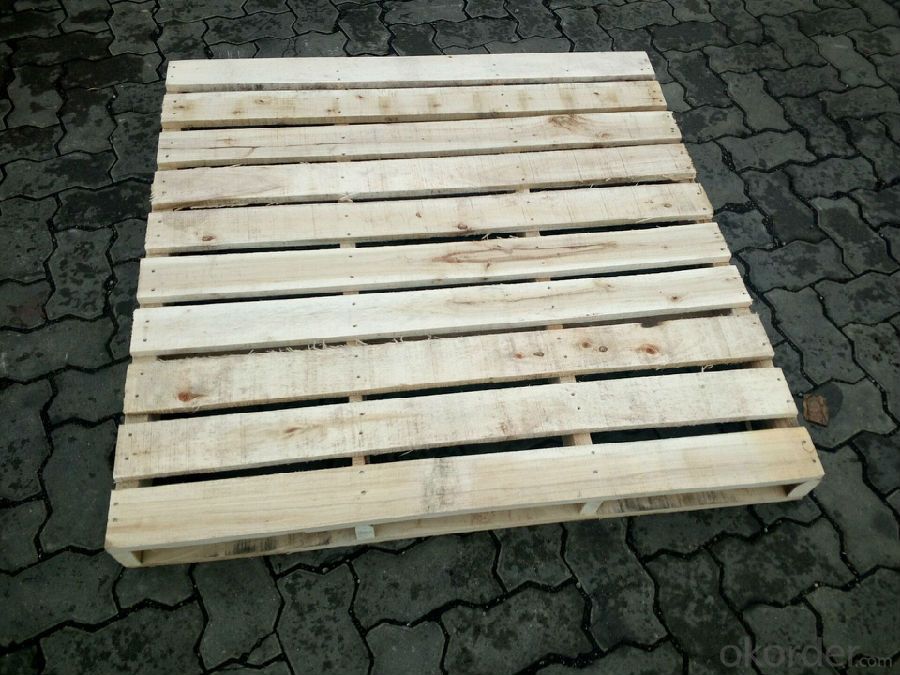
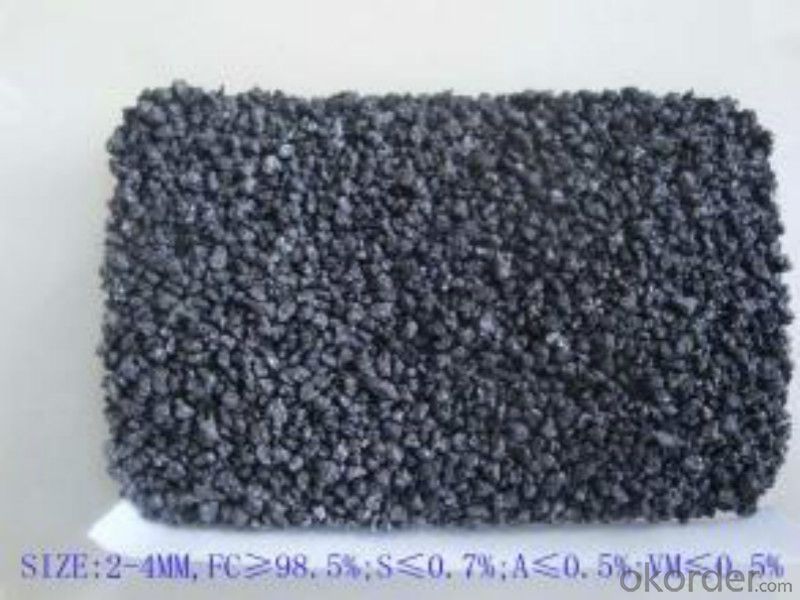

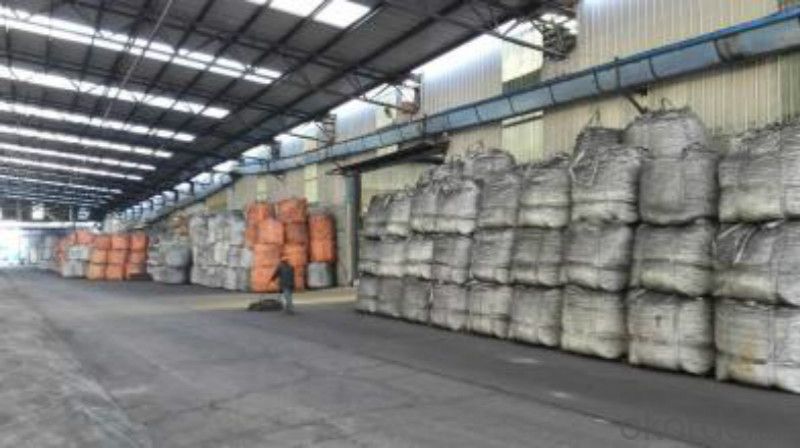
FAQ:
1.MOQ:2 Containers |
2.Size:1-3mm,1-5mm,2-6mm,3-5mm and as the customer's requirement |
3.Packing: 1 ton jumbo bag or 25kgs paper in bag |
4.Payment:T/T or L/C at sight |
5.Delivery time: within 15 days after receiving the deposit |
6.Usage: it is as carbon raiser,widely used in steelmaking,casting,casting iron,steel foundry,aluminum metallury. |
- Q: Which is better, 13 and 14 carbon breath tests?
- Two kinds of carbon synthesis conditions are different, the instruments are not the same, so lead to price differences
- Q: What are the impacts of carbon emissions on natural disasters?
- Carbon emissions contribute to the intensification and frequency of natural disasters. The release of greenhouse gases, such as carbon dioxide, traps heat in the atmosphere, leading to global warming and climate change. This warmer climate alters weather patterns, resulting in more frequent and severe events like hurricanes, droughts, wildfires, and floods. Additionally, the melting of polar ice caps due to increased temperatures raises sea levels, making coastal regions more vulnerable to storm surges and causing further devastation. Overall, carbon emissions exacerbate the impact of natural disasters, posing significant threats to human lives, ecosystems, and economies.
- Q: What's a carbon cloth to do as a fish pole?
- This is difficult, usually with a lathe like tool, by heating in the brush, layer by layer roll up, and finally cut off paint, baking
- Q: What is carbon black ink?
- The main component of carbon black ink is carbon black pigment. Carbon black, a fine powder produced from carbon through incomplete combustion of hydrocarbons, is commonly used as a pigment in the ink industry due to its intense black color, excellent opacity, and resistance to UV rays. When it comes to applications, carbon black ink is widely utilized in printing, writing, and drawing. It can be found in ballpoint pens, fountain pens, markers, and printer inks. The ink's high concentration of carbon black pigment ensures a deep and solid black color on different surfaces, including paper. One of the advantages of carbon black ink is its durability. It has exceptional lightfastness, meaning it does not fade or change color when exposed to light over time. This is particularly crucial for applications that require long-lasting or archival-quality ink, such as art or document preservation. Moreover, carbon black ink exhibits good water resistance and adhesion properties, making it suitable for use on various materials like paper, cardboard, and plastics. Its high viscosity ensures consistent and smooth ink flow, allowing for precise and consistent writing or printing. In conclusion, carbon black ink is a versatile and reliable ink that offers an intense black color, excellent durability, and good adhesion properties. Its widespread use in various writing and printing applications showcases its quality and dependability.
- Q: How do you use carbon fourteen to measure the age?
- One is obvious a small amount of sample, only 1 ~ 5 mg samples can be, such as a piece of fabric, bone chips, toner trace of ancient ceramics in the surface or pores can be measured; while the conventional carbon - 14 dating rules 1 to 5 grams of samples differ by 3 orders of magnitude. The two is high sensitivity. The sensitivity of 10-15 to 10-16 isotope ratio measurement; while the conventional carbon - 14 dating rules with a difference of 5 to 7 orders of magnitude. Three is a short measurement time, measurement of modern carbon to reach 1% accuracy, only 10 to 20 minutes; while the conventional carbon - 14 dating is 12 ~ 20 hours. It is due to carbon - 14 accelerator mass spectrometry dating method has the advantage, since its inception, has been paid attention to by archaeologists, paleontologists and geologists, and is widely used. It can be said that within 50000 years of cultural relics on the determination of samples, carbon - 14 accelerator mass spectrometry dating method is determined the accuracy of a maximum of 1. carbon. 14 is a radioactive isotope of carbon, was found in 1940. It is produced by cosmic rays collide with a nitrogen atom in the air, which has a half-life of about 5730 years, as the decay of beta decay, 14 atoms into carbon nitrogen atoms.
- Q: What are the properties of carbon-based ceramics?
- Carbon-based ceramics have a unique combination of properties that make them highly desirable materials. They exhibit excellent high-temperature stability, exceptional chemical resistance, and high mechanical strength. Additionally, they have low density, low thermal expansion, and good electrical conductivity. These properties make carbon-based ceramics suitable for a wide range of applications, including in aerospace, automotive, and electronics industries.
- Q: How is carbon used in the production of nanotubes?
- Carbon is used in the production of nanotubes by being arranged in a unique structure where carbon atoms are bonded together in a hexagonal lattice, forming a tube-like structure. This arrangement allows for the formation of nanotubes with exceptional mechanical, electrical, and thermal properties, making them ideal for various applications in fields such as electronics, materials science, and medicine.
- Q: How does carbon impact the availability of clean drinking water?
- The availability of clean drinking water can be significantly affected by carbon through various processes. One major way carbon impacts water quality is through the formation of acid rain caused by carbon dioxide emissions. When carbon dioxide combines with water in the atmosphere, it forms carbonic acid, which can be extremely harmful to water bodies. Freshwater sources can be devastated by acid rain, primarily caused by the release of carbon emissions from industrial activities and the burning of fossil fuels. This can result in a decrease in the pH level of lakes, rivers, and groundwater, making the water more acidic. The increased acidity can harm aquatic life, destroy ecosystems, and make water sources unsuitable for drinking, agriculture, or industrial use. Furthermore, carbon can affect the availability of clean drinking water through its role in climate change. Excessive carbon emissions contribute to the greenhouse effect, leading to rising global temperatures and changes in weather patterns. These changes can cause prolonged droughts and intense rainfall events, both of which can have negative effects on water availability and quality. Climate change-induced droughts can cause water scarcity as precipitation patterns become less predictable and water sources dry up. This can result in conflicts over limited water resources and force communities to rely on contaminated or unsafe water sources. Conversely, intense rainfall events caused by climate change can lead to flooding, overwhelming sewage systems and contaminating drinking water with pollutants and pathogens. Additionally, carbon emissions are linked to the degradation of natural ecosystems, such as forests and wetlands, which play a crucial role in water purification. Forests act as natural filters, absorbing carbon dioxide and releasing oxygen, while wetlands naturally filter and cleanse water. When these ecosystems are destroyed or degraded due to deforestation or drainage, the availability of clean drinking water is further compromised. To conclude, carbon emissions have a significant impact on the availability of clean drinking water. Acid rain formation, climate change-induced droughts and floods, and the degradation of natural ecosystems all contribute to water scarcity and contamination. It is crucial to protect and reduce carbon emissions in order to ensure the availability of clean drinking water for both present and future generations.
- Q: Is there a line cutting of carbon fibers?
- The principle of ultrasonic cutting machine is completely different from traditional cutting. It is the use of ultrasonic energy, will be cut materials local high-speed vibration, so as to achieve the purpose of cutting materials.Water cutting is the formation of water through high pressure jet, for carbon fiber board also need to add hard abrasive in water, called water jet cuttingFor complete curing of the carbon fiber composite plate, if there is no special requirements, with diamond grinding tools can also cut the general. I don't know what you're asking for.Carbon fiber composite cutting methods are many, and laser cutting, etc., need to be selected according to specific circumstances and requirements.
- Q: What is carbon black used for?
- Carbon black serves a multitude of purposes across a range of industries. Its primary function lies in its use as a pigment and reinforcing filler in the production of rubber goods, including tires, hoses, and belts. The addition of carbon black significantly enhances the strength, durability, and resistance to abrasion of rubber materials. Furthermore, carbon black proves invaluable as a coloring agent in inks, paints, and coatings due to its exceptional light-absorbing properties. It imparts a deep black hue and improves the UV resistance of these products. Additionally, carbon black finds utility in the plastic manufacturing process where it acts as a filler, enhancing the mechanical properties of plastic components while simultaneously reducing costs. Within the energy sector, carbon black finds application as a conductive additive in batteries and fuel cells. Its high electrical conductivity significantly boosts the performance of these energy storage devices. Moreover, carbon black is employed in the production of electrodes for supercapacitors, thanks to its expansive surface area that facilitates efficient energy storage. Beyond this, carbon black also plays a role in the construction industry, serving as a reinforcing agent in concrete and asphalt. By bolstering the strength and durability of these materials, carbon black renders them more resistant to cracking and weathering. In summary, carbon black is a widely utilized substance across a diverse range of industries, including rubber production, plastic manufacturing, ink, paint, and coating formulation, energy storage device creation, and construction. Its properties as a pigment, reinforcing filler, coloring agent, and conductive additive make it an invaluable material in various industrial applications.
Send your message to us
Calcined Pitch Coke with Ash 0.5 percent max uses as furnace
- Loading Port:
- Tianjin
- Payment Terms:
- TT OR LC
- Min Order Qty:
- 21 m.t.
- Supply Capability:
- 8000 m.t./month
OKorder Service Pledge
OKorder Financial Service
Similar products
Hot products
Hot Searches
Related keywords
